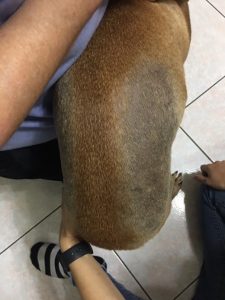
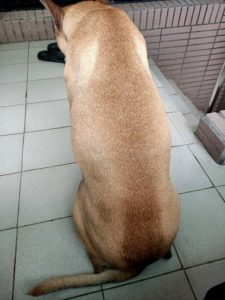
We develop a anti-inflammation therapeutic drug for dog skin inflammation
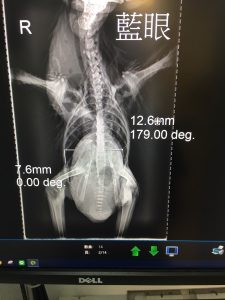
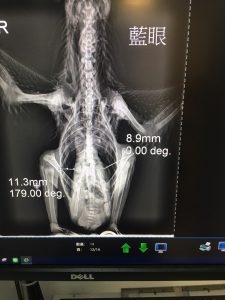
Our lab product(IFA-parrot1 product) can cure the PDD caused by Bornavirus infection in Parrot
Ho TC, Chang CC, Chan HP, Chung TW, Shu CW, Chuang KP, Duh TH, Yang MH, Tyan YC: Hydrogels: Properties and Applications in Biomedicine. Molecules 2022, 27(9).(co-first author)
Chang C-C, Ho T-C, Lien C-Y, Shen DH-Y, Chuang K-P, Chan H-P, Yang M-H, Tyan Y-C: The Effects of Prior Mammography Screening on the Performance of Breast Cancer Detection in Taiwan. In: Healthcare: 2022. MDPI: 1037.
Yang MH, Chen YA, Tu SC, Chi PL, Chuang KP, Chang CC, Lee CH, Chen YL, Lee CH, Yuan CH et al: Utilizing an Animal Model to Identify Brain Neurodegeneration-Related Biomarkers in Aging. Int J Mol Sci 2021, 22(6).
Tsai CY, Hu SY, Santos HM, Catulin GEM, Tayo LL, Chuang KP: Probiotic supplementation containing Bacillus velezensis enhances expression of immune regulatory genes against pigeon circovirus in pigeons (Columba livia). J Appl Microbiol 2021, 130(5):1695-1704.
5. Shen DH, Chan HP, Tsai FR, Hu C, Chen AY, Chan HY, Lee CH, Chuang KP, Yang MH, Tyan YC: Prognostic Value of (18)F-FDG PET/CT Volume-Based Metabolic Parameters in Patients with Node-Negative Stage II Esophageal Squamous Cell Carcinoma. Metabolites 2021, 12(1).
Padzil F, Mariatulqabtiah AR, Tan WS, Ho KL, Isa NM, Lau HY, Abu J, Chuang KP: Loop-Mediated Isothermal Amplification (LAMP) as a Promising Point-of-Care Diagnostic Strategy in Avian Virus Research. Animals (Basel) 2021, 12(1).
Huang HY, Silva BBI, Tsai SP, Tsai CY, Tyan YC, Lin TC, Flores RJD, Chuang KP: Immunogenicity and Protective Activity of Pigeon Circovirus Recombinant Capsid Protein Virus-Like Particles (PiCV rCap-VLPs) in Pigeons (Columba livia) Experimentally Infected with PiCV. Vaccines (Basel) 2021, 9(2).
Ho TC, Wang YH, Chen YL, Tsai WC, Lee CH, Chuang KP, Chen YA, Yuan CH, Ho SY, Yang MH et al: Chloroquine and Hydroxychloroquine: Efficacy in the Treatment of the COVID-19. Pathogens 2021, 10(2).
Ho TC, Chen YA, Chan HP, Chang CC, Chuang KP, Lee CH, Yuan CH, Tyan YC, Yang MH: The Effects of Heterologous Immunization with Prime-Boost COVID-19 Vaccination against SARS-CoV-2. Vaccines (Basel) 2021, 9(10).
Ho TC, Chang CC, Chan HP, Huang YF, Chen YA, Chuang KP, Lee CH, Yuan CH, Deng YZ, Yang MH et al: Pulmonary Findings of [(18)F]FDG PET/CT Images on Asymptomatic COVID-19 Patients. Pathogens 2021, 10(7).
Ching-Chi Chang †, Benji Brayan I. Silva † , Huai-Ying Huang , Ching-Yi Tsai, Ronilo Jose D. Flores, Lemmuel L. Yu-Chang Tyan, Ming-An Tsai , Gail Everette M. Catulin, Kuo-Pin Chuang ,* and Jenq-Lin Yang* (2021) Development and Validation of KASP Assays for the Genotyping of Racing Performance-Associated Single Nucleotide Polymorphisms in Pigeons. Genes 12,1381. IF 4.04 (co-corresponding author, Q2)
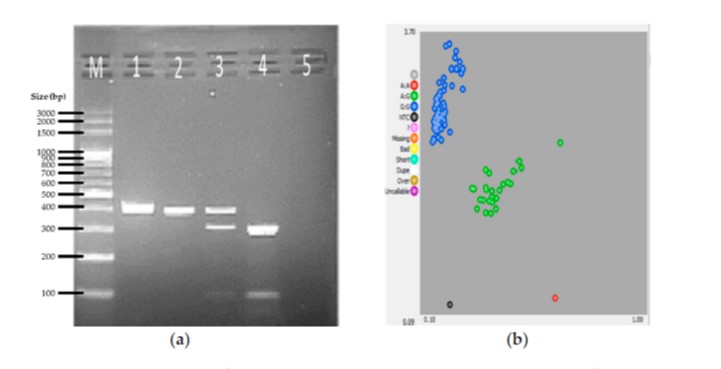
Representative results for LDHA gene SNP genotyping by PCR-RFLP and KASP assays. (a) Agarose gel electrophoretic profile of selected samples showing the banding patterns for the undigested PCR amplicon (lane 1), the LDHAAA allele (lane 2), LDHAAG allele (lane 3), and LDHAGG allele. (b) Cluster plot for the KASP genotyping assay: LDHAAA allele (red cluster), LDHAAG allele (green cluster), and LDHAGG allele (blue cluster).
Huai-Ying Huang, Benji Brayan I Silva, Shen-Pang Tsai, Ching-Yi Tsai, Yu-Chang Tyan, Tzu-Che Lin, Ronilo Jose D Flores, Kuo-Pin Chuang. (2021). 9(2). Immunogenicity and Protective Activity of Pigeon Circovirus Recombinant Capsid Protein Virus-Like Particles (PiCV rCap-VLPs) in Pigeons (Columba livia) Experimentally Infected Vaccines, 9, 2, 98-105 (corresponding author IF:4.4 Q1)
Antibody response of pigeons to PiCV rCap-VLPs vaccination. Two groups (10 pigeons/group) were utilized in this study. The control group was immunized with saline supplemented with water-in-oil-in-water (W/O/W) adjuvant, while the VLP group was immunized with PiCV rCap-VLPs. Pigeons in both groups were immunized twice (at 28 and 42 days of age). Antibody titers were determined at 0, 14, and 21 days post-vaccination (dpv) by ELISA quantified by optical density reading at 405 nm. Significant difference between groups (p < 0.05) was notated as *.
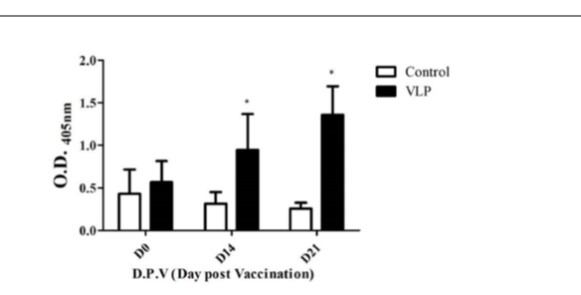
Santos, H.M., Tsai, C.-Y., Catulin, G.E.M., Trangia, K.C.G., Tayo, L.L., Liu, H.-J., Chuang, K.P., 2020. Common Bacterial, Viral and Parasitic Diseases in Pigeons (Columba livia): A Review of Diagnostic and Treatment Strategies. Veterinary Microbiology, 108779.( corresponding Ranking: Q1, IF: 3.03 Veterinary Subcategory: 4 / 165 2.4%)
Pigeons (Columba livia) have been associated to humans for a long time now. They are raised for sport (pigeon race), exhibition (display of fancy breeds), food and research. Most of the pigeons kept are Racing Homers, trained to compete in the pigeon race. Other breeds, such as Rollers, Nose Divers, Doneks are bred for their aerial abilities. Incorporation of good preventive medicine program is one of the most critical factors in averting infectious diseases in pigeon flocks. This review summarizes the common bacterial, viral and parasitic infections in pigeons. The different clinical signs, symptoms, diagnostic strategies, prevention and treatments were described in this review. Current researches, molecular diagnostic assays and treatment strategies such as vaccines and drug candidates were included. The information found in this review can provide insights for veterinarians and researchers studying pigeons to develop an effective and efficient immunoprophylactic and diagnostic tools for pigeon diagnosis and therapeutics.
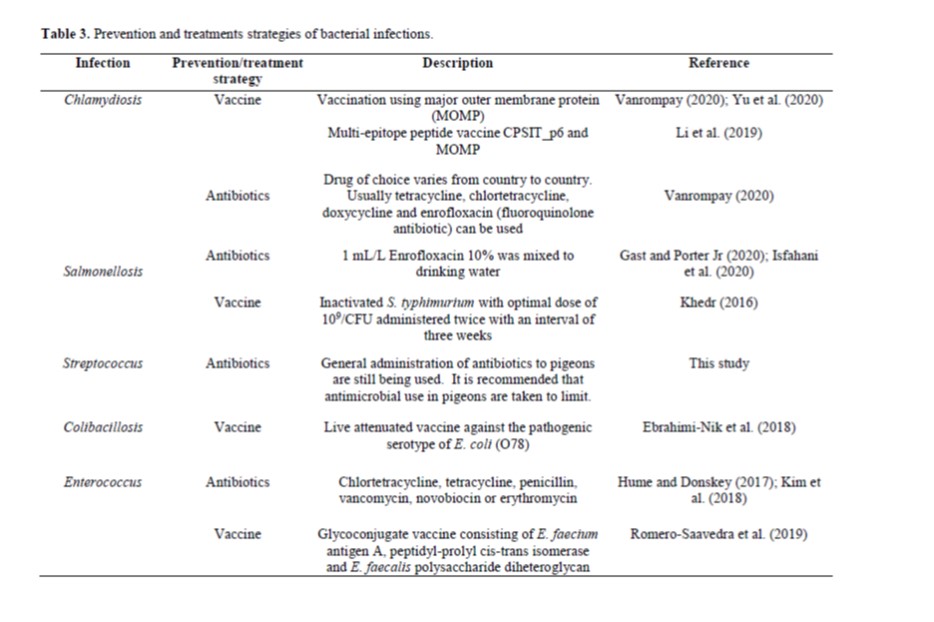
Santos, H.M., Chen, C.C., Tsai, C.-Y., Hsish, Y.C., Chung, F.C., Tyan, Y.-C., Tayo, L.L., Chuang, K.P., 2020a. Influence of pigeon interferon alpha (PiIFN-α) on pigeon circovirus (PiCV) replication and cytokine expression in Columba livia. Veterinary Microbiology 242, 108591.( Corresponding author Ranking: Q1, IF: 3.03 Veterinary Subcategory: 4 / 165 2.4%)
Pigeon circovirus (PiCV) is the most diagnosed virus in pigeons (Columba livia) and have been studied and reported globally. PiCV infections can lead to immunosuppression and pigeons infected with PiCV can result to
lymphocyte apoptosis and atrophy of immune organs. Young pigeon disease syndrome (YPDS) is a complexdisease and believed that PiCV could be one of the agents leading to this syndrome. An effective treatment regimen is needed to control the spread of PiCV in pigeons. In this study pigeon interferon alpha (PiIFN-α) was cloned and expressed and its antiviral effects were tested against fowl adenovirus type 4 (FAdV-4) in vitro and
PiCV in vivo. No detectable levels of FAdV-4 viral genome in LMH cells stimulated with 300 μg/mL PiIFN-α were found. Additionally, PiIFN-α was stable at different temperature and pH for 4 h, and no reduction in antiviral
activity was observed in untreated and treated cells. In pigeons naturally and experimentally infected by PiCV,no detectable levels of PiCV virus titers were found after treatment with PiIFN-α. Cytokine and ISG expression
levels in liver and spleen samples were detected and IFN-γ and Mx1 genes were dominantly up-regulated following PiIFN-α treatment (p<0.05). This study demonstrated that PiCV can be inhibited by administration of PiIFN-α and PiFN-α can be used as a therapeutic approach to prevent the spread of PiCV in pigeons.

Fold change of pigeon circovirus (PiCV) viral loads in fecal swabs from pigeons (A) naturally and (B) experimentally infected with PiCV. Pigeons were treated with phospahte buffered saline (PBS), 100 μg , 200 μg and 300 μg PiIFN-α treated either orally or subcutaneously. Pigeons naturally infected with PiCV were treated twice a day at a 12 h interval and pigeons experimentally infected with PiCV were treated once a day. Fecal swabs were collected for PiCV viral load quantification by qPCR. Viral loads were expressed as means±standard deviation of fold change. * p<0.05 between each experimental groups.
Santos, H.M., Tsai, C.-Y., Maquiling, K.R.A., Tayo, L.L., Mariatulqabtiah, A.R., Lee, C.-W., Chuang, K.P., 2020b. Diagnosis and potential treatments for acute hepatopancreatic necrosis disease (AHPND): a review. Aquaculture International 28, 169-185.(corresponding author Ranking : Q2, IF: 1.363 Agronomy and Crop Science: 94/320 29% )
Acute hepatopancreatic necrosis disease (AHPND) or formerly known as early mortality syndrome (EMS) is an emerging disease that has caused significant economic losses to the aquaculture industry. The primary causative agent of AHPND is Vibrio parahaemolyticus, a Gram-negative rod-shaped bacterium that has gained plasmids encoding the fatal binary toxins
Pir A/Pir B that cause rapid death of the infected shrimp. In this review, the current research studies and information about AHPND in shrimps have been presented. Molecular diagnostic tools and potential treatments regarding AHPND were also included. This review also includes
relevant findings which may serve as guidelines that can help for further investigation and studies on AHPND or other shrimp diseases.
Tsai, C.-Y., Santos, H.M., Hu, S.-Y., Sang, C.Y., Yanuaria, C.A.S., Lola, E.N.G., Tayo, L.L., Nitura, K.M.A., Liu, C.H., Chuang, K.P., 2019. LpxD gene knockout elicits protection to Litopenaeus vannamei, white shrimp, against Vibrio parahaemolyticus infection. Aquaculture International 27, 1383-1393. (corresponding author Ranking: Q2, IF: 1.363 Agronomy and Crop Science: 94/320 29% )
Vibrio parahaemolyticus is a Gram-negative bacterium causing acute hepatopancreatic necrosis disease (AHPND) in white shrimp, Litopenaeus vannamei. LpxD gene, a principal component of lipid A, which plays a vital role in the biosynthesis of lipopolysaccharides (LPSs) responsible for
the pathogenesis of Gram-negative bacteria However, the function of lpxD in V. parahaemolyticus’ virulence has not been studied. In this study, lpxD gene knockout and its role in V. parahaemolyticus’ virulence in white shrimp were determined. The lpxD gene was knocked out by homologous recombination. Virulence and immunogenicity of the lpxD gene was disrupted and the pirA, the major virulence factor of AHPND, and AP1 gene were intact in white shrimp. White shrimp fed with normal diet with VP△lpxD displayed protection (reduced mortality rate from 66 to 27%) after challenge with V. parahaemolyticus. Our results indicated that knockout of
the lpxD gene can cause attenuation of V. parahaemolyticus in white shrimp, and VP△lpxD could be used as a live attenuated oral vaccine against V. parahaemolyticus in white shrimp.
 Cumulative moratality rate of white shrimps challenged with V. parahaemolyticus hours post challenge.Four groups (30 shrimps/group) were carried out in this trial, including two controls: shrimp fed with normal diet with PBS for 14 days, then challenged with pathogen after 1 day of feeding then another group is shrimp fed with normal diet with PBS for 14 days with no challenge and the two treatments: shrimp fed normal diet with VP△lpxD or crab VP for 14 days, then challenged with pathogen after 1 day of feeding. Only shrimps at intermolt were used. Shrimps in all groups were fed twice daily at 5% of their biomass, and the water temperature was
Cumulative moratality rate of white shrimps challenged with V. parahaemolyticus hours post challenge.Four groups (30 shrimps/group) were carried out in this trial, including two controls: shrimp fed with normal diet with PBS for 14 days, then challenged with pathogen after 1 day of feeding then another group is shrimp fed with normal diet with PBS for 14 days with no challenge and the two treatments: shrimp fed normal diet with VP△lpxD or crab VP for 14 days, then challenged with pathogen after 1 day of feeding. Only shrimps at intermolt were used. Shrimps in all groups were fed twice daily at 5% of their biomass, and the water temperature was
maintained at 28 ± 1 °C during the entire trial. Each group was carried out in triplicate and similar results were found. Experimental infection was carried out by an oral challenge. Significant difference (p < 0.05)